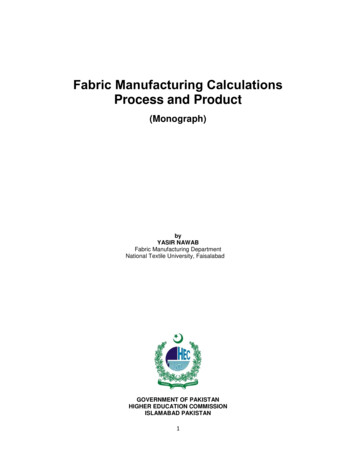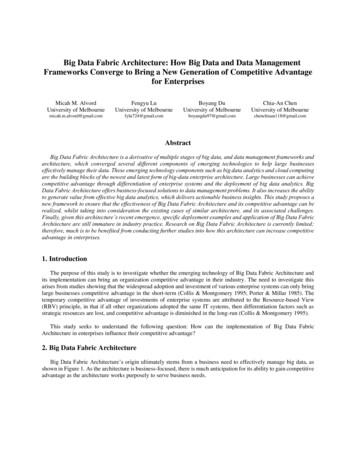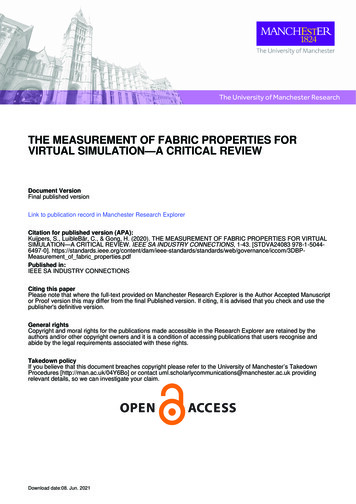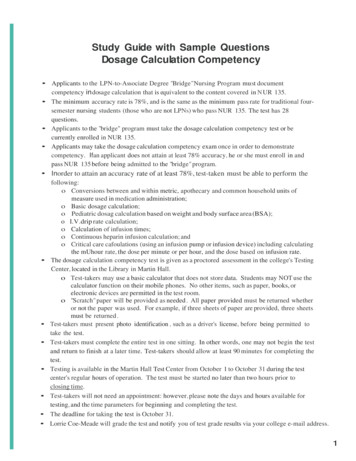
Transcription
Fabric Manufacturing CalculationsProcess and Product(Monograph)byYASIR NAWABFabric Manufacturing DepartmentNational Textile University, FaisalabadGOVERNMENT OF PAKISTANHIGHER EDUCATION COMMISSIONISLAMABAD PAKISTAN1
Copyrights @ Higher Education CommissionIslamabadLahoreKarachiPeshawarQuettaAll rights are reserved. No part of this publication may be reproduced, or transmitted, in any formor by any means – including, but not limited to, electronic, mechanical, photocopying, recording, or,otherwise or used for any commercial purpose what so ever without the prior written permission ofthe publisher and, if publisher considers necessary, formal license agreement with publisher maybe executed.Project: “Monograph and Textbook Writing Scheme” aims to develop a culture of writing and todevelop authorship cadre among teaching and researcher community of higher educationinstitutions in the country. For information please visit: www.hec.gov.pkHEC – Cataloging in Publication (CIP Data):Yasir Nawab, Dr.Fabric Manufacturing Calculations: Process and ProductIncludes IndexI.Textile Engineering677.6 – dc23 2017ISBN: 978-969-417-193-7First Edition: 2017Copies Printed: 500Published By: Higher Education Commission – PakistanDisclaimer: The publisher has used its best efforts for this publication through a rigorous system ofevaluation and quality standards, but does not assume, and hereby disclaims, any liability to any personfor any loss or damage caused by the errors or omissions in this publication, whether such errors oremissions result from negligence, accident, or any other cause.2
TABLE OF .11.21.31.41.51.61.71.8Yarn countIndirect count systemDirect Count SystemCount conversionsFolded Yarn CountCost of Folded yarnConditioningAverage Winding RateCoil angle and wind angleWinding machine productionPackage .43.23.2.13.2.23.3WarpingDirect warpingSet calculationsWarp beam capacityQuality of warp yarnWarping machine efficiencySectional warpingSectional Warping CalculationsSection Building on Section .54.64.74.84.94.104.114.124.13SizingWarp tension zone calculationsSize liquor concentrationSize add onSize box occupationSizing recipe calculationSizing costYarn stretchSize recipe calculationsWeavers beam spaceSize solution requirementSteam requirementSize Solution DosageExercise43434545454648495051545455563
p and weft calculationsContraction%Material requiredFabric areal densityDerivation of the relationCost of productionRaw material costConversion costProfitability ng shedWarp tensionReed countReed widthMaximum ends per inch (EPImax)Loom productionFabric shrinkage%Weaving shed ManagementAir consumption calculationWeaver’s allocationNumber of air changesFabric inspectionGrading systemsPoints per linear meter/square 5Fabric GeometryStructural parameters of woven fabricsYarn diameterFabric thicknessCover factorYarn crimpFabric areal densityFabric geometry modelsPierce’s modelModified Pierce’s modelKemp’s race track modelHearle’s lenticular modelLimitations of geometrical .38.28.2.18.2.28.38.48.58.5.18.5.28.5.3Specialty fabricsTerry towelParts of a conventional terry towelGeneral calculationsTotal picksRelation of Pounds/dozen of towel with GsmPounds per dozenPile and Ground Ends Calculation per Towel and per BeamPile and Ground beam space calculationTowel weight calculationsTowel Construction CalculationTowel Production CalculationsPile and Ground Beam length (Set length) CalculationDirect warping 5
8.68.78.88.9Ball warpingFilament warpingSample warping and ingFabric AnalysisOptimum knitting calculationYarn CompositionYarn requirementTerry fabrics (two end and three end)Jersey Lycra fabricStriper fabricKnitted Fabric DimensionsAreal density, GSMWidthCam and needle requirementFor Single knit and its derivatives,For double knit structureProduction calculations of Circular knitting MachineWarp knitting calculationsProduction 1171171171181191211211225
DedicationThis work is dedicated to the faculty members of FabricManufacturing Department of National Textile University.6
ACKNOWLEDGEMENTFirst and foremost, I would like to thank Allah who gave us strength, knowledge and capability tocomplete this piece of work. Two years ago we had this discussion in our team about lack of anycompiled data based on calculation. We would jump to supporting in writing a book covering all theaspects in the target field. I would like to express my sincere gratitude to my colleagues, who sawme through this book; to all those who provided support, talked things over, read, wrote, offeredcomments, and assisted in the editing, proofreading and design. Their determined efforts haveturned this book into a reality.I would like to thank the Higher Education Commission, Pakistan for providing us the opportunityto publish this book.7
PREFACEThe textile fabrics have a wide range of application in areas like apparels, home textiles andtechnical textiles. The manufacture of a cost effective quality product requires the careful planningand thorough knowledge of the production process. This objective cannot be achieved without theknow-how of the calculations involved in the fabric formation process. The latest developments andautomation in the textile machinery has resulted in a more efficient production cycle. Unfortunately,the published work available on the topic of woven fabric calculations is quite out dated, while nosignificant work has been reported on the calculations of knitted fabrics.This book is organised into nine different chapters. Chapter 1 focuses on the systems for lineardensity of yarn, and their inter-conversion. Chapter 2 addresses the winding calculations. Chapter3 and 4 are dedicated to warping and sizing calculations respectively. Chapter 5 is clothcalculations, while chapter 6 is weaving shed calculations. Chapter 7 highlights different theoriesand structural parameter of fabric geometry, while chapter 8 includes specialty calculations liketerry towel, ball warping, filament warping and sample warping. The chapter 9 is dedicated to theknitting calculations, both warp and weft knitting.The whole range of steps and calculations involved in the fabric formation process from amount ofraw material to the costing of final product have been included in the book. I hope, this book isequally beneficial for the beginners, textile engineering students and professionals of the field.Dr. Yasir NawabNational Textile University8
CHAPTER – 1YARN COUNT CALCULATIONSMuhammad Umair, Yasir NawabYarn countYarn count is a system of expressing the fineness of yarn in terms of thickness. It is therelationship between the weight and length of yarn made. Different types of count systemsformed for different types of yarn materials. Broadly the yarn count system is divided into twomajor categories: Indirect count systemDirect count system1.1Indirect count systemIn this system the count of yarn expresses the number of length units in one weight unit.This system is generally used for cotton, worsted, woollen, linen (wet spun), etc. It may be notedthat finer or less bulky the yarn, higher is its count number or in other words, the size or bulkinessof the yarn is inversely proportional to the count number and that is why the system is known asindirect system.𝐼𝑛𝑑𝑖𝑟𝑒𝑐𝑡 𝐶𝑜𝑢𝑛𝑡 𝐿𝑒𝑛𝑔𝑡ℎ 𝑖𝑛 𝑎𝑝𝑝𝑟𝑜𝑝𝑟𝑖𝑎𝑡𝑒 𝑢𝑛𝑖𝑡𝑊𝑒𝑖𝑔ℎ𝑡 𝑖𝑛 𝑎𝑝𝑝𝑟𝑜𝑝𝑟𝑖𝑎𝑡𝑒 𝑢𝑛𝑖𝑡Keeping in view the yarn material, different types of indirect count systems weredeveloped like:𝐶𝑜𝑡𝑡𝑜𝑛 𝐶𝑜𝑢𝑛𝑡 𝑁𝑒𝑐 8.33 �𝑠)𝑊𝑜𝑟𝑠𝑡𝑒𝑑 𝐶𝑜𝑢𝑛𝑡 𝑁𝑒𝑤𝑠 12.5 𝑊𝑜𝑜𝑙𝑙𝑒𝑛 𝐶𝑜𝑢𝑛𝑡, 𝑁𝑒𝑤𝑙 27.34 𝐷𝑒𝑐𝑖𝑚𝑎𝑙 𝐶𝑜𝑢𝑛𝑡, 𝑁𝑒𝑑𝑐 7 ��𝑎𝑖𝑛𝑠)
𝑀𝑒𝑡𝑟𝑖𝑐 𝐶𝑜𝑢𝑛𝑡, 𝑁𝑀 𝐿(𝐾𝑚𝑠)𝐿(𝑀𝑡𝑟𝑠) 𝑊(𝐾𝑔𝑠) 𝑊(𝐺𝑟𝑚𝑠)𝐹𝑟𝑒𝑛𝑐ℎ 𝐶𝑜𝑢𝑛𝑡, 𝑁𝑒𝑓𝑟 1/2 𝐿(𝑀𝑡𝑟𝑠)𝑊(𝐺𝑟𝑚𝑠)Direct Count System1.2In this system the count of yarn expresses the number of weight units in one length unit.This system is generally used for silk, artificial silk, jute, etc. The size or bulkiness of the yarn isdirectly proportional to the count number. A coarser yarn will have a higher count number whilefiner yarn will have a lower count number. The system is used for very finer or very coarse yarns.𝐷𝑖𝑟𝑒𝑐𝑡 𝐶𝑜𝑢𝑛𝑡 𝑊𝑒𝑖𝑔ℎ𝑡 𝑖𝑛 𝑎𝑝𝑝𝑟𝑜𝑝𝑟𝑖𝑎𝑡𝑒 𝑢𝑛𝑖𝑡𝐿𝑒𝑛𝑔𝑡ℎ 𝑖𝑛 𝑎𝑝𝑝𝑟𝑜𝑝𝑟𝑖𝑎𝑡𝑒 𝑢𝑛𝑖𝑡Keeping in view the yarn material, different types of direct count systems were developedlike:𝑇𝑒𝑥 𝐶𝑜𝑢𝑛𝑡 1000 ��𝑛𝑖𝑒𝑟 𝑐𝑜𝑢𝑛𝑡 9000 ��𝑐𝑖𝑇𝑒𝑥 𝑜𝑟 𝐺𝑟𝑒𝑥 𝑐𝑜𝑢𝑛𝑡 10000 𝐷𝑟𝑎𝑚 𝑐𝑜𝑢𝑛𝑡 ��𝑖𝑔ℎ (𝐷𝑟𝑎𝑚) 1000 𝑊(𝐺𝑟𝑎𝑖𝑛𝑠) 𝐿 �)Table 1.1 Different yarn count systemsSr #Name of SystemUnit of weightUnit of Length1English cotton1 lb.Hank of 840 yards2French cotton½ kg.Hank of 1000 meters3Bump cotton1 oz.1 yard4Decimal (for all yarns)1 lbHank of 1000 yards10
5Metric1 kg.Hank of 1000 meters6Worsted1 lb.Hank of 560 yardsWoollen (Yorkshire Skein)6 lbs.Skein or Hank of 1536 yardsWoollen (American Cut)1 lb.Cut of 300 yards.Woollen (American Run)1 oz.Run of 100 yardsWoollen (West of England)1 lb.Snap of 320 yards78Linen (wet spun)1 lb.Lea of 300 yards.9Spun Silk1 lb.Hank of 840 yards10Jute, Hemp and Flax1 lb.Hank of 14,400 yards.11Tex1 gramHank of 1000 meters12Denier1 gramHank of 9000 meters13Deci-Tex/Grex1 gramHank of 10,000 meters14Dram15Fiber glass1 dram 27.34grains1 lb.1 𝑝𝑜𝑢𝑛𝑑 (𝑙𝑏) 16 𝑜𝑢𝑛𝑐𝑒𝑠 7000 𝑔𝑟𝑎𝑖𝑛𝑠 453.6 𝑔𝑟𝑎𝑚𝑠1 𝑜𝑢𝑛𝑐𝑒 (𝑜𝑧) 28.35 𝑔𝑟𝑎𝑚𝑠1 𝑘𝑖𝑙𝑜𝑔𝑟𝑎𝑚 (𝑘𝑔) 2.2046 𝑙𝑏𝑠1 𝑚𝑒𝑡𝑒𝑟(𝑚) 1.0936 𝑦𝑎𝑟𝑑𝑠 (𝑦𝑑𝑠)1 𝑑𝑟𝑎𝑚 27.34 𝑔𝑟𝑎𝑖𝑛Different count systems are given below11Hank of 1000 yardsHank of 100 yards
𝐶𝑜𝑡𝑡𝑜𝑛 𝐶𝑜𝑢𝑛𝑡 𝐿𝑒𝑛𝑔𝑡ℎ 𝑖𝑛 ℎ𝑎𝑛𝑘𝑠𝑊𝑒𝑖𝑔ℎ𝑡 𝑖𝑛 𝑙𝑏𝑠Spun silk or spun rayon staple fiber system is same as English cotton count system:𝑀𝑒𝑡𝑟𝑖𝑐 𝐶𝑜𝑢𝑛𝑡 𝐿𝑒𝑛𝑔𝑡ℎ 𝑖𝑛 ��𝑔ℎ𝑡 𝑖𝑛 ��𝑖𝑐 𝐶𝑜𝑢𝑛𝑡 𝐿𝑒𝑛𝑔𝑡ℎ 𝑖𝑛 𝑚𝑒𝑡𝑒𝑟𝑠𝑊𝑒𝑖𝑔ℎ𝑡 𝑖𝑛 𝑔𝑟𝑎𝑚𝑠𝐿𝑖𝑛𝑒𝑛 𝑜𝑟 𝐻𝑒𝑚𝑝 𝑠𝑦𝑠𝑡𝑒𝑚 𝑊𝑜𝑟𝑠𝑡𝑒𝑑 𝑠𝑦𝑠𝑡𝑒𝑚 𝑊𝑜𝑟𝑠𝑡𝑒𝑑 𝑠𝑦𝑠𝑡𝑒𝑚 𝐿𝑒𝑛𝑔𝑡ℎ 𝑖𝑛 𝑙𝑒𝑎𝑠𝑊𝑒𝑖𝑔ℎ𝑡 𝑖𝑛 𝑙𝑏𝑠𝐿𝑒𝑛𝑔𝑡ℎ 𝑖𝑛 ℎ𝑎𝑛𝑘𝑠𝑊𝑒𝑖𝑔ℎ𝑡 𝑖𝑛 𝑙𝑏𝑠7000 𝐿𝑒𝑛𝑔𝑡ℎ 𝑖𝑛 𝑦𝑎𝑟𝑑𝑠560 𝑊𝑒𝑖𝑔ℎ𝑡 𝑖𝑛 ��𝑛 𝐶𝑢𝑡 𝑠𝑦𝑠𝑡𝑒𝑚 𝑓𝑜𝑟 𝑊𝑜𝑜𝑙𝑙𝑒𝑛 𝑦𝑎𝑟𝑛𝑠 𝐴𝑚𝑒𝑟𝑖𝑐𝑎𝑛 𝐶𝑢𝑡 𝑠𝑦𝑠𝑡𝑒𝑚 𝑓𝑜𝑟 𝑊𝑜𝑜𝑙𝑙𝑒𝑛 𝑦𝑎𝑟𝑛𝑠 𝐿𝑒𝑛𝑔𝑡ℎ 𝑖𝑛 𝑦𝑎𝑟𝑑𝑠/300𝑊𝑒𝑖𝑔ℎ𝑡 𝑖𝑛 𝑙𝑏𝑠𝑌𝑜𝑟𝑘𝑠ℎ𝑖𝑟𝑒 𝐶𝑢𝑡 𝑠𝑦𝑠𝑡𝑒𝑚 𝑓𝑜𝑟 𝑊𝑜𝑜𝑙𝑙𝑒𝑛 𝑦𝑎𝑟𝑛𝑠 𝑌𝑜𝑟𝑘𝑠ℎ𝑖𝑟𝑒 𝐶𝑢𝑡 𝑠𝑦𝑠𝑡𝑒𝑚 𝑓𝑜𝑟 𝑊𝑜𝑜𝑙𝑙𝑒𝑛 𝑦𝑎𝑟𝑛𝑠 𝐽𝑢𝑡𝑒, 𝐹𝑙𝑎𝑥 𝑎𝑛𝑑 𝐻𝑒𝑚𝑝 𝑐𝑜𝑢𝑛𝑡 𝐽𝑢𝑡𝑒, 𝐹𝑙𝑎𝑥 𝑎𝑛𝑑 𝐻𝑒𝑚𝑝 𝑐𝑜𝑢𝑛𝑡 𝐿𝑒𝑛𝑔𝑡ℎ 𝑖𝑛 𝑐𝑢𝑡𝑠𝑊𝑒𝑖𝑔ℎ𝑡 𝑖𝑛 𝑙𝑏𝑠𝐿𝑒𝑛𝑔𝑡ℎ 𝑖𝑛 𝑠𝑘𝑒𝑖𝑛𝑠𝑊𝑒𝑖𝑔ℎ𝑡 𝑖𝑛 𝑙𝑏𝑠/67000 𝐿𝑒𝑛𝑔𝑡ℎ 𝑖𝑛 𝑦𝑎𝑟𝑑𝑠256 𝑊𝑒𝑖𝑔ℎ𝑡 𝑖𝑛 𝑔𝑟𝑎𝑖𝑛𝑠𝑊𝑒𝑖𝑔ℎ𝑡 𝑖𝑛 𝑙𝑏𝑠𝐿𝑒𝑛𝑔𝑡ℎ 𝑖𝑛 𝑠𝑝𝑦𝑛𝑑𝑙𝑒𝑠72 𝑊𝑒𝑖𝑔ℎ𝑡 𝑖𝑛 𝑔𝑟𝑎𝑖𝑛𝑠35 𝐿𝑒𝑛𝑔𝑡ℎ 𝑖𝑛 𝑦𝑎𝑟𝑑𝑠Example 1.1:If 1 bundle contains 200 hanks of cotton yarn, what is the count of yarn? (1 bundle 10 lbs.)Solution:12
We know that,𝐶𝑜𝑡𝑡𝑜𝑛 𝐶𝑜𝑢𝑛𝑡 𝐿𝑒𝑛𝑔𝑡ℎ 𝑖𝑛 ℎ𝑎𝑛𝑘𝑠𝑊𝑒𝑖𝑔ℎ𝑡 𝑖𝑛 𝑙𝑏𝑠𝐶𝑜𝑡𝑡𝑜𝑛 𝐶𝑜𝑢𝑛𝑡 20010𝐶𝑜𝑡𝑡𝑜𝑛 𝐶𝑜𝑢𝑛𝑡 20 𝑠Example 1.2:How many hanks are there in 7 bundles of 60’s cotton yarn?Solution:We know that, 5 bundles 7 10 70 lbs𝐶𝑜𝑡𝑡𝑜𝑛 𝐶𝑜𝑢𝑛𝑡 𝐿𝑒𝑛𝑔𝑡ℎ 𝑖𝑛 ℎ𝑎𝑛𝑘𝑠𝑊𝑒𝑖𝑔ℎ𝑡 𝑖𝑛 𝑙𝑏𝑠𝐶𝑜𝑡𝑡𝑜𝑛 𝐶𝑜𝑢𝑛𝑡 𝑊𝑒𝑖𝑔ℎ𝑡 𝑖𝑛 𝑙𝑏𝑠 𝐿𝑒𝑛𝑔𝑡ℎ 𝑖𝑛 ℎ𝑎𝑛𝑘𝑠𝐿𝑒𝑛𝑔𝑡ℎ 𝑖𝑛 ℎ𝑎𝑛𝑘𝑠 𝐶𝑜𝑡𝑡𝑜𝑛 𝐶𝑜𝑢𝑛𝑡 𝑊𝑒𝑖𝑔ℎ𝑡 𝑖𝑛 𝑙𝑏𝑠𝐿𝑒𝑛𝑔𝑡ℎ 𝑖𝑛 ℎ𝑎𝑛𝑘𝑠 60 70𝐿𝑒𝑛𝑔𝑡ℎ 𝑖𝑛 ℎ𝑎𝑛𝑘𝑠 4200Example 1.3:If 120 kilometers of yarn weigh 3.5 kilogrammes, what will be the count in metric system?Solution:In metric system, we know that13
𝑀𝑒𝑡𝑟𝑖𝑐 𝐶𝑜𝑢𝑛𝑡 𝐿𝑒𝑛𝑔𝑡ℎ 𝑖𝑛 ��𝑔ℎ𝑡 𝑖𝑛 ��𝑡𝑟𝑖𝑐 𝐶𝑜𝑢𝑛𝑡 1203.5𝑀𝑒𝑡𝑟𝑖𝑐 𝐶𝑜𝑢𝑛𝑡 34′𝑠1.3Count conversionsIn many cases of yarn count conversions, we need to convert one type of direct or indirectcount system to another type of direct or indirect count system to get equivalent count. If,L1 Length in known system,L2 Length in required systemW1 Weight in known system,W2 Weight in required systemC1 Count in known system,C2 Count in required systemWe can convert to any required system by using the concerned formula as given below:1. Indirect to Indirect:𝐿1𝑊2𝐶2 𝐶1 ( )𝐿2𝑊12. Direct to Indirect:𝐶2 1𝐿1𝑊2 ( )𝐶1𝐿2𝑊13. Direct to Direct:𝐿2𝑊1𝐶2 𝐶1 ( )𝐿1𝑊24. Indirect to Direct:𝐶2 1𝐿2𝑊1 ( )𝐶1𝐿1𝑊2When we will use indirect to direct, the given or known count will be indirect and when we willuse direct to indirect formula then given or known count will be direct.14
Example 1.4:Convert 70’s woollen (grains) USA into Jute count.Solution:To convert from Direct to Direct system, we know that,𝐿2𝑊1𝐶2 𝐶1 ( )𝐿1𝑊2L1 Length in known system,L2 Length in required systemW1 Weight in known system,W2 Weight in required systemC1 Count in known system,C2 Count in required system𝐶2 70 (1 14400)20 7000𝐶2 70 0.102𝐶2 7.2 𝑙𝑏𝑠/𝑠𝑝𝑖𝑛𝑑𝑙𝑒Example 1.5:Convert 20’s metric count into cotton count.Solution:To convert from Indirect to Indirect system, we know that,𝐿1𝑊2𝐶2 𝐶1 ( )𝐿2𝑊1L1 Length in known system,L2 Length in required systemW1 Weight in known system,W2 Weight in required systemC1 Count in known system,C2 Count in required systemIn cotton count length is 840 yards and weight is 1 lb, while in metric count length is 1000meter and weight is 1 kg. So,15
1000 1.09361𝐶2 20 ( )8401 2.2046Since, 1m 1.0936 yards, 1kg 2.2046 lbs𝐶2 20 1.301 0.4535𝐶2 20 0.590𝐶2 11.8 𝑠Example 1.6:Convert 10’s worsted count into woollen count.Solution:To convert from Indirect to Indirect system, we know that,𝐿1𝑊2𝐶2 𝐶1 ( )𝐿2𝑊1L1 Length in known system,L2 Length in required systemW1 Weight in known system,W2 Weight in required systemC1 Count in known system,C2 Count in required systemIn worsted count hank length is 560 yards and weight is 1 lb, while in woollen count hanklength is 256 yards and weight is 1 lb. So,𝐿1𝑊2𝐶2 𝐶1 ( )𝐿2𝑊1𝐶2 10 (5601 )2561𝐶2 10 2.18𝐶2 21.8Example 1.7:Convert 10’s Linen count into English cotton count.16
Solution:To convert from Indirect to Indirect system, we know that,𝐿1𝑊2𝐶2 𝐶1 ( )𝐿2𝑊1L1 Length in known system,L2 Length in required systemW1 Weight in known system,W2 Weight in required systemC1 Count in known system,C2 Count in required systemIn Linen count hank length is 300 yards and weight is 1 lb, while in Cotton count hanklength is 840 yards and weight is 1 lb. So,𝐿1𝑊2𝐶2 𝐶1 ( )𝐿2𝑊1𝐶2 10 (3001 )8401𝐶2 10 [0.357]𝐶2 3.57 𝑠Example 1.8:Convert 600 Denier count into Tex count.Solution:To convert from Direct to Direct system, we know that,𝐿2𝑊1𝐶2 𝐶1 ( )𝐿1𝑊2L1 Length in known system,L2 Length in required systemW1 Weight in known system,W2 Weight in required systemC1 Count in known system,C2 Count in required system17
We know that, in Denier count system length is 9000m and weight is 1 gram, while in Texcount system length is 1000m and weight is 1 gram.𝐿2𝑊1𝐶2 𝐶1 ( )𝐿1𝑊2𝐶2 600 (10001 )90001𝐶2 66.6Example 1.9:Convert 20’s Cotton count into Tex count.Solution:To convert from Indirect to Direct system, we know that,𝐶2 1𝐿2𝑊1 ( )𝐶1𝐿1𝑊2L1 Length in known system,L2 Length in required systemW1 Weight in known system,W2 Weight in required systemC1 Count in known system,C2 Count in required systemWe know that, in Cotton count hank length is 840 yards and weight is 1 lb, while in Texcount system length is 1000m and weight is 1 gram.𝐶2 𝐶2 1𝐿2𝑊1 ( )𝐶1𝐿1𝑊211000453.6 1 ( )20840 0.91441Since, 1 m 0.1944 yards and 1 lb. 453.6 grams𝐶2 11000453.6 ( )20768.1118
𝐶2 1 1.30 453.620𝐶2 29.52Example 1.9:Convert 30 Tex count into Cotton count.Solution:To convert from Indirect to Direct system, we know that,𝐶2 1𝐿1𝑊2 ( )𝐶1𝐿2𝑊1L1 Length in known system,L2 Length in required systemW1 Weight in known system,W2 Weight in required systemC1 Count in known system,C2 Count in required systemWe know that, in Tex count system length is 1000m and weight is 1 gram, while in Cottoncount hank length is 840 yards and weight is 1 lb,𝐶2 𝐶2 1𝐿1𝑊2 ( )𝐶1𝐿2𝑊111000453.6 ( )30768.11𝐶2 1 1.30 453.630𝐶2 19.68 20 𝑠19
The count conversion for some mostly common systems is given citex(dtex)1 Nm1.693 Nec1.129 worsted1000/tex9000 / den10000 /dtexCotton(Nec)0.591 Nm1 NecWorsted /1.5591/tex5315 / den5905 /dtexWorstedNm / 1.1291.5 Nec1 worsted886/tex7972 / den8858 /dtexTex1000 / Nm590.5 /Nec885.5 /worsted1 texDen / 9Dtex / 109000 / Nm5315 / Nec7972 /worsted9 tex1 den0.9 dtex10000 /Nm5905 / Nec8858 /worsted10 tex1.11 den1 dtexMetric(Nm)Denier(den)Decitex(dtex)1.4Folded Yarn CountThe counts of folded yarns in cotton, linen and worsted are expressed in terms of thecounts of the single threads of which the folded yarn is composed. There will be some contractionin length when two threads are twisted together; so that the actual count of single threadrequired producing a twofold yarn of 21s count will be slightly finer than 42s. But this contractionis not significant in ordinary cases.To calculate the count of folded yarn, assume a definite length unit, say one hank. Thenthe weight of such length unit of each component threads is found out. The sum of these weights20
will be the weight of the assumed length unit of resultant folded yarn. The length and weightbeing known; the count of the folded yarn can be easily calculated by using suitable formula asgiven below.For Indirect Count System111 𝑅𝐶 𝑅1 𝑅2And for ‘n’ number of yarn counts1111 𝑅𝐶 𝑅1 𝑅2𝑅𝑛For Direct Count System𝑅𝐶 𝑅1 𝑅2And for ‘n’ number of yarn counts𝑅𝐶 𝑅1 𝑅2 𝑅𝑛Where, R1, R2, and Rc are the count of 1st individual, 2nd individual and resultant yarnsrespectively.Note: The counts should be in same system.Example 1.10:Calculate the resultant count of three-fold cotton yarn consists of 20’s, 30’s and 15’s.Solution:1 hank of 20’s 1/20 lb.1 hank of 30’s 1/30 lb.1 hank of 15’s 1/15 lb.So, for three-fold yarn:21
1 ℎ𝑎𝑛𝑘 𝑜𝑓 𝑡ℎ𝑟𝑒𝑒 𝑓𝑜𝑙𝑑 𝑦𝑎𝑟𝑛 1119 𝑙𝑏𝑠203015 60Therefore, the resultant count three-fold yarn𝑅𝑒𝑠𝑢𝑙𝑡𝑎𝑛𝑡 𝑐𝑜𝑢𝑛𝑡 [1]𝑊𝑒𝑖𝑔ℎ𝑡 𝑖𝑛 𝑙𝑏𝑠 𝑜𝑓 1 ℎ𝑎𝑛𝑘 𝑜𝑓 𝑡ℎ𝑟𝑒𝑒 𝑓𝑜𝑙𝑑 𝑦𝑎𝑟𝑛 [1]9/60𝑅𝑒𝑠𝑢𝑙𝑡𝑎𝑛𝑡 𝑐𝑜𝑢𝑛𝑡 6.66 7′ 𝑠Example 1.11:A two-fold cotton yarn having 8’s and a thread of unknown count was found to be of 4’s cotton.Find the unknown count of yarn.Solution:1 hank of 8’s 1/8 lb.1 hank of two-fold yarn 1/4 lb.Therefore, 1 hank of unknown yarn1 hank of unknown yarn 11 1 𝑙𝑏𝑠48 8Count of unknown yarn [1]𝑊𝑒𝑖𝑔ℎ𝑡 𝑖𝑛 𝑙𝑏. 𝑜𝑓 1 ℎ𝑎𝑛𝑘 𝑜𝑓 𝑢𝑛𝑘𝑛𝑜𝑤𝑛 𝑦𝑎𝑟𝑛 [1]1/8 8′ 𝑠 Cotton1.5Cost of Folded yarnThe end price of folded yarns depends upon the cost of its every component yarns. If theconstituent yarns are of same count, the calculation will be very simple and easy. But if the foldedyarn is composed of yarns of different counts, the cost of the resultant yarn count will dependupon the proportion of the constituent yarns in the folded yarn.22
If two yarns are folded together, andA Count of 1st yarnB Count of 2nd yarny Cost of 1st yarnz Cost of 2nd yarnCost of folded yarn (material) 𝐶𝑓 𝐴𝑧 𝐵𝑦𝐴 𝐵In case of three yarns, folded together,A Count of 1st yarnB Count of 2nd yarnC Count of 3rd yarny Cost of 1st yarnz Cost of 2nd yarnw Cost of 3rd yarnCost of folded yarn (material) 𝐶𝑓 𝐴𝐵(𝑤) 𝐴𝐶(𝑧) 𝐵𝐶(𝑦)𝐴𝐵 𝐴𝐶 𝐵𝐶𝑇𝑜𝑡𝑎𝑙 𝑐𝑜𝑠𝑡 𝑜𝑓 𝑓𝑜𝑙𝑑𝑒𝑑 𝑦𝑎𝑟𝑛, 𝐶𝑓 ′ 𝐶𝑓 ���𝑑𝑖𝑛𝑔 cost𝐶𝑓′ 𝐶𝑓 𝐶𝐶Example 1.12:Calculate the price per pound of two fold yarn by twisting together 20’s and 30’s. Price of 20’sand 30’s per pound is Rs-18 and Rs-35 respectively. The doubling cost per pound is Rs-2.Solution:If,23
A Count of 1st yarnB Count of 2nd yarny Cost of 1st yarnz Cost of 2nd yarnCost of folded yarn material can be calculated as under:𝐶𝑓 𝐶𝑓 𝐴𝑧 𝐵𝑦𝐴 𝐵(20 35) (30 18)(20 30)𝐶𝑓 700 54050𝐶𝑓 32.2Total cost of folded yarn is:𝐶𝑓′ 𝐶𝑓 𝐶𝐶𝐶𝑓′ 32.2 2 34.2 𝑅𝑠.1.6ConditioningAll textile materials are more or less hygroscopic. They contain a certain amount ofmoisture, depending on the relative humidity of the surrounding atmosphere in which they arekept. So in determining the weight of the yarn or a fabric it is necessary to have the weight takenunder standard condition. Also while selling or purchasing cotton yarn their price is fixed on theirconditioned weight. While doing the textile materials business, one should know about themoisture regain (MR) and moisture content (MC) of the material. The amount of moistureabsorbed by the oven dry weight of the material when exposed to the atmosphere is called asmoisture regain of the material.𝑀𝑜𝑖𝑠𝑡𝑢𝑟𝑒 𝑅𝑒𝑔𝑎𝑖𝑛 (𝑀𝑅)% 𝑂𝑟𝑖𝑔𝑖𝑛𝑎𝑙 𝑤𝑒𝑖𝑔ℎ𝑡 𝑂𝑣𝑒𝑛 𝑑𝑟𝑦 𝑤𝑒𝑖𝑔ℎ𝑡 100𝑂𝑣𝑒𝑛 𝑑𝑟𝑦 𝑤𝑒𝑖𝑔ℎ𝑡While the amount of moisture contained in a material and is expressed as percentage onits original weight is called moisture content.24
𝑀𝑜𝑖𝑠𝑡𝑢𝑟𝑒 𝑐𝑜𝑛𝑡𝑒𝑛𝑡 (𝑀𝐶)% 𝑂𝑟𝑖𝑔𝑖𝑛𝑎𝑙 𝑤𝑒𝑖𝑔ℎ𝑡 𝑂𝑣𝑒𝑛 𝑑𝑟𝑦 𝑤𝑒𝑖𝑔ℎ𝑡 100𝑂𝑟𝑖𝑔𝑖𝑛𝑎𝑙 𝑤𝑒𝑖𝑔ℎ𝑡The most important term for doing business in textile is the conditioned weight (correct invoiceweight) of the material. If there is less moisture in the cotton than the normal, the buyer will begainer and seller will be loser to an extent depending upon the deficiency of the cotton in respectof moisture content. To avoid this problem while doing business of the materials like: cotton, theirprice is fixed on conditioned � 𝑤𝑒𝑖𝑔ℎ𝑡 𝑜𝑓 𝑦𝑎𝑟𝑛 𝑊𝐶 𝑊𝑂 (𝑀𝑅% 𝑊𝑜 )100WO Oven dry weight (The weight of the material obtained by heating the material in aconditioning oven at 220-230 F, until it attains the constant weight).Example 1.13:The oven dry weight of 690 yards of cotton yarn is 45 grains. What is the conditioned count ofthe yarn?Solution:We know that,𝑀𝑅%Conditioned weight of yarn, 𝑊𝐶 𝑊𝑂 ( 𝑊𝑜 )1008.5Conditioned weight of yarn, 𝑊𝐶 45 ( 45)100Conditioned weight of yarn, 𝑊𝐶 45 3.82Conditioned weight of yarn, 𝑊𝐶 48.82 𝑔𝑟𝑎𝑖𝑛𝑠Example 1.14:The oven dry weight of the 220 grains of cotton is found to be 200 grains. Calculate the moistureregain, moisture content and conditioned weight of the cotton.25
Solution:𝑀𝑜𝑖𝑠𝑡𝑢𝑟𝑒 𝑅𝑒𝑔𝑎𝑖𝑛 (𝑀𝑅)% 𝑂𝑟𝑖𝑔𝑖𝑛𝑎𝑙 𝑤𝑒𝑖𝑔ℎ𝑡 𝑂𝑣𝑒𝑛 𝑑𝑟𝑦 𝑤𝑒𝑖𝑔ℎ𝑡 100𝑂𝑣𝑒𝑛 𝑑𝑟𝑦 �𝑒 𝑅𝑒𝑔𝑎𝑖𝑛 (𝑀𝑅)% 220 200 100200𝑀𝑜𝑖𝑠𝑡𝑢𝑟𝑒 𝑅𝑒𝑔𝑎𝑖𝑛 (𝑀𝑅)% 20 100200𝑀𝑜𝑖𝑠𝑡𝑢𝑟𝑒 𝑅𝑒𝑔𝑎𝑖𝑛 (𝑀𝑅) 10 %𝑀𝑜𝑖𝑠𝑡𝑢𝑟𝑒 𝑐𝑜𝑛𝑡𝑒𝑛𝑡 (𝑀𝐶)% 𝑂𝑟𝑖𝑔𝑖𝑛𝑎𝑙 𝑤𝑒𝑖𝑔ℎ𝑡 𝑂𝑣𝑒𝑛 𝑑𝑟𝑦 𝑤𝑒𝑖𝑔ℎ𝑡 100𝑂𝑟𝑖𝑔𝑖𝑛𝑎𝑙 �𝑒 𝑐𝑜𝑛𝑡𝑒𝑛𝑡 (𝑀𝐶)% 220 200 100220𝑀𝑜𝑖𝑠𝑡𝑢𝑟𝑒 𝑐𝑜𝑛𝑡𝑒𝑛𝑡 (𝑀𝐶)% 20 100220𝑀𝑜𝑖𝑠𝑡𝑢𝑟𝑒 𝑐𝑜𝑛𝑡𝑒𝑛𝑡 (𝑀𝐶) 9.09 𝑑 𝑤𝑒𝑖𝑔ℎ𝑡 𝑜𝑓 𝑦𝑎𝑟𝑛, 𝑊𝐶 𝑊𝑂 ( 𝑊𝑜 � 𝑤𝑒𝑖𝑔ℎ𝑡 𝑜𝑓 𝑦𝑎𝑟𝑛, 𝑊𝐶 200 ( � 𝑤𝑒𝑖𝑔ℎ𝑡 𝑜𝑓 𝑦𝑎𝑟𝑛, 𝑊𝐶 200 17The different textile materials have different moisture regain and moisture content as given below.Table 1.2 Moisture Regain and Moisture Content of Different FibersMaterial NameMoisture Regain %Moisture Content %Cotton8.57.83Flax, Hemp1210.7Jute13.7512.1Silk119.91Viscose Rayon119.9126
1.7Rayon Acetate65.66Worsted (Yarn)18.2515.4Woollen (Yarn)1714.5Nylon4.23.78Average CountThe term average count indicates the calculated count determined from the total lengthand total weight of the different counts of yarn in question. And by this total length and totalweight we can find the average count in the required system.Example 1.15: Calculate the average count of 80/S, 50/S, 40/S and 20/S cotton yarn.Solution:C1:C2:C3:C480:50:40:20Taking L.C.M. of all four counts,L.C.M 400This means we have to take 400 hanks of each count.Now,400 ℎ𝑎𝑛𝑘𝑠 𝑜𝑓 80/𝑆 𝑤𝑒𝑖𝑔ℎ𝑠 𝐿𝑒𝑛𝑔𝑡ℎ(ℎ𝑎𝑛𝑘𝑠) 400 5 𝑙𝑏𝑠𝐶𝑜𝑢𝑛𝑡80400 ℎ𝑎𝑛𝑘𝑠 𝑜𝑓 50/𝑆 𝑤𝑒𝑖𝑔ℎ𝑠 𝐿𝑒𝑛𝑔𝑡ℎ(ℎ𝑎𝑛𝑘𝑠) 400 8 𝑙𝑏𝑠𝐶𝑜𝑢𝑛𝑡50400 ℎ𝑎𝑛𝑘𝑠 𝑜𝑓 40/𝑆 𝑤𝑒𝑖𝑔ℎ𝑠 𝐿𝑒𝑛𝑔𝑡ℎ(ℎ𝑎𝑛𝑘𝑠) 400 10 𝑙𝑏𝑠𝐶𝑜𝑢𝑛𝑡40400 ℎ𝑎𝑛𝑘𝑠 𝑜𝑓 20/𝑆 𝑤𝑒𝑖𝑔ℎ𝑠 𝐿𝑒𝑛𝑔𝑡ℎ(ℎ𝑎𝑛𝑘𝑠) 400 20 𝑙𝑏𝑠𝐶𝑜𝑢𝑛𝑡20Total number of hanks 400 400 400 400 1600 hanks,27
Total weight 5 8 10 20 43 lbs𝐴𝑣𝑒𝑟𝑎𝑔𝑒 𝑐𝑜𝑢𝑛𝑡 )𝑤𝑒𝑖𝑔ℎ𝑡(𝑙𝑏𝑠) 160043 37.2SExerciseProblem 1: Show that 1 oz 28.3 gms.Problem 2: Show that 1 oz/yd2 33.9 grams/m2.Problem 3: Show that 1 lb/in2 0.06895 bar𝐿(𝑦𝑎𝑟𝑑𝑠)Problem 4: Show that in indirect system 𝑁𝑒𝑐 8.33 𝑊(𝑔𝑟𝑎𝑖𝑛𝑠)Problem 5: Show that in indirect system 𝑁𝑒𝑤𝑠 12.5 lem 6: Show that in indirect system 𝑁𝑚 𝑊(𝐾𝑔𝑠) 𝑊(𝐺𝑟𝑚𝑠)12Problem 7: Show that in indirect system 𝑁𝑒𝑓𝑟 m 8: If 240 yards of cotton yarn weight 40 grains, what is the count of yarn in English cottonsystem?Problem 9: Find the weight of 270 yards of 60S cotton.Problem 10: What is length of 105 grains of 40S cotton yarn?Problem 11: How many hanks are contained in 5 bundles of 80S cotton yarn?Problem 12: Find the count in worsted system of yarn if 650 m weigh 55 grains.Problem 13: If 840 yards of worsted yarn weigh 50 grains. What will be the count of yarn?Problem 14: The weight of 768 yards of woollen yarn is 0.25 lbs. What is the count of yarn?Problem 15: Calculate the count in French cotton system of 100 m of cotton yarn if weight is 4grams.Problem 16: If the weight of 60 km of cotton yarn is 5 kgs. What is the count of yarn in Frenchcotton and metric system?Problem 17: 45 yards of cotton was found to be weigh 5 grains. Calculate its count in decimalsystem?Problem 18: Show that in direct system 𝑇𝑒𝑥 𝐶𝑜𝑢𝑛𝑡 𝑇𝑒𝑥 1000 m 19: Show that in direct system 𝐷𝑒𝑛𝑖𝑒𝑟 𝑐𝑜𝑢𝑛𝑡 𝐷𝑒𝑛𝑖𝑒𝑟 9000 m 20: If 350 meters of silk yarn weigh 7.5 grains. What is the count of yarn in denier system?Problem 21: What is the weight of 270 meter of Nylon yarn whose count is 200 denier.Problem 22: Calculate the count of 5000 yards of cotton yarn in Tex system, if its weight is 10ounces.Problem 23:The length of a quality of 42 Tex Nylon is 7 Km. Calculate the weight of yarn inounces?28
Problem 24: If 27432 yards of acetate yarn weight 240 grams. What is its count in Tex and Grexsystem?Problem 25: Find the length of 40 ounces & 11 drams of silk yarn, whose count is 150 drams.Problem 26: Show that, Linen count 0.853 Woollen countProblem 27: A warp is composed of 40/2 and 30/1 cotton yarn in proportion of 2 ends of 40/2 &12 ends of 30/1 yarn. Calculate the average count of yarn in warp.Problem 28: A warp consists of yards of following particulars. Calculate the average count; (a) 3lbs of 20s yarn. (b) 6 lbs of 16s yarn. (c) 9 lbs of 24s yarn.Problem 29: Given a compound twisted thread, which is made up of one thread of 20 Ne spunviscous, one thread of 20/2 ply Ne worsted & one thread of 80 denier polyesterfilament yarn. Find the resultant yarn count in the Tex, denier & cotton system.Problem 30: If the oven dry weight of 7200 yards of Jute yarn is 2 lbs. then calculate itsconditioned count (direct system). The percentage of M.R of Jute is13.75%.Problem 31: Convert 20s cotton into Worsted system.Problem 32: Convert 135 denier into Tex count.Problem 33: Calculate the equivalent count of 163 Tex into Grex system.Problem 34: Convert 100s cotton into Denier system.Problem 35: Convert 20 Tex into Worsted count.5315Problem 36: Show that for cotton count 𝑁𝑒 𝐷𝑒𝑛𝑖𝑒𝑟Problem 37: Show that 𝑁𝑒 0.59𝑁𝑚Problem 38: Calculate the counts of 3 fold cotton yarn composed of 20/1, 15/1 and 12/1.Problem 39: One thread of an unknown count, when folded together with another 72/1 cottonyarn gives a twofold yarn of 31.5 cotton. Calculate the count of unknown thread.Problem 40: A 3-fold cotton yarn is composed of 8s, 24s & a thread of un-known count was foundto be a 4s cotton. Calculate the count of unknown thread.Problem 41: Calculate the count of the corkscrew yarn produced by twisting together one threadof 2/40S and the other of 10s cotton. By actual measurement it was found that 20inches of 10S thread and 10 inches of 2/40S are contained in 10 inches of corkscrewyarn.Problem 42: A yarn of 36/1 costs 42Rs/lb & 12/1 yarn costs 14 Rs/lb. What is the cost of yarncomposed of two twisted threads?Problem 43: Find the cost of 3 folded yarn composed of 60/1, 40/1 & 20/1 & cost of yarn/lb is 32,24 & 16Rs/lb respectively. If folding cost is 55 Rs/lb.Problem 44: Calculate the cost of 4 ply yarn of 80s, 60s, 50s& 40s yarn. If their cost is 40, 36, 32 &24 Rs/lb. If folding/conversion cost is 0.85 Rs/lb.Problem 45: A folded yarn is composed of one thread of 14 Tex & other of 12 Tex. Their price isRs9 & Rs 10 per pound respectively. Calculate the cost of folded yarn, if conversioncost is 0.35 Rs/kg.29
Problem 46: The conditioned count of a yarn is 20s cotton. What is the oven dry weight of 16hanks of such yarn?Problem 47: Calculate the conditioned count of cotton yarn in Tex system, if oven dry weight of24 km yarn is 32grams.30
CHAPTER – 2WINDING CALCULATIONSYasir Nawab, Khubab ShakerWindingWinding is a process in which yarn from ring bobbins (comes from spinning department)are wound into convenient form of package. Transferring a yarn from one type of package toanother package, more suitable for subsequent process is also called winding. Main objectives ofwinding include: Changing package size/shape according to requirement of subsequent processClearing yarn defects like slub, thick and thin places, neps, etcDoubling the yarn2.1Winding RateWinding rate is the speed at which the yarn is wound on package surface. In case ofparallel package, the traverse is very slow, so the winding rate is approximately equal to thesurface speed (πDN). But in case of cross wound package, where traverse is quick, its effect onwinding rate must be taken into account. In this case, the surface speed and traverse speed ofyarn both contribute to the actual winding rate.VTBAVSVRθO31
Figure 2.1 Traverse and Surface velocity in case of cross wound packageThe traverse velocity (VT) is at right angles to surface velocity (VS), as shown in Figure 2.1.Vector addition of both these velocities produces the resultant winding velocity (VR). Let,AB Traverse speed of yarn, VTOB Surface speed of drum, VSOA Resultant speed of yarn, VRThen,(OA)2 (OB)2 (AB)2𝑉𝑅 2 𝑉𝑆 2 𝑉𝑇 2 Eq. 2.1If,D Diameter of grooved drum,N RPM of drumThen,VS πDNPutting values of VS in Eq.2.1, we getVR2 (πDN)2 VT2𝑉𝑅 (𝜋𝐷𝑁)2 𝑉𝑇 2 E
me through this book; to all those who provided support, talked things over, read, wrote, offered comments, and assisted in the editing, proofreading and design. Their determined efforts have turned this book into a reality. I would like to thank the Higher Education Commission, Pakistan for providing











